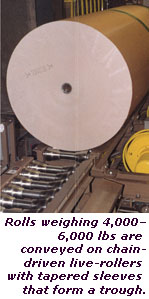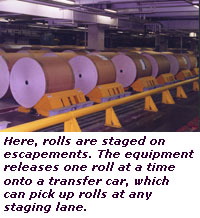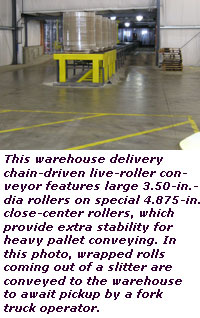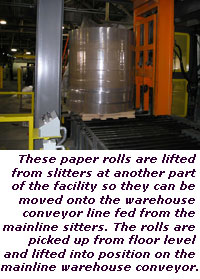Paper Roll Handling: What's Right For You?
- Published: May 31, 2007, By By FKI Logistex North America
June Web Exclusive
With the potential to improve productivity, worker safety, and the bottom line dramatically, paper roll handling automation is making its way into many operations. Taking a cue from conventional non-paper manufacturing and distribution operations that have seen substantial benefits from automation, converters are recognizing that paper rolls can be safely and efficiently handled at higher volumes more quickly, accurately, and cost effectively while improving the quality of their finished products.
A variety of material handling options - from conveying to palletizing to storage and retrieval - can save companies that handle paper rolls significant time and money, prevent accidents on the factory floor, and improve product consistency and quality. Choosing from these options, or even choosing to automate at all, can be tricky.

Ground Rules for Automation
The first step in determining whether your paper handling operation is a candidate for automation is to assess the physical characteristics of the rolls you want to handle and determine where in your manufacturing process they appear. Are they coming out of process? How much do they weigh? How tall and big around are they? Are there multiple sizes and weights? Do they need to be cut or otherwise handled? Do you want the process to be totally automated or will manual labor be on-hand to assist?
Answers to these questions will shape the parameters of your material handling application and help you determine if there are factors that might impede automation. They also will help you determine to what extent software should be used to automate the process so human intervention is structured and minimized. You may want your system to perform in a virtual “lights-out” mode, for example, where no human interaction is required and the system runs itself, or you may be interested in a solution that features a level of human interaction.
Oddly shaped, heavy items like paper rolls bring a host of special requirements to an automated material-handling project. The cylindrical shape of a roll and its size are factors that can be easily engineered. For instance, a paper roll application might require that rolls that need to be conveyed are palletized first, and then conveyed on their pallets.

Dimensions and weights greater than typical paper rolls may require special engineering and custom-built equipment. Roll weights in excess of 10,000 lbs require modifications to conveying equipment, for example. In such a case, paper roll handling would be automated with more robustly designed and engineered equipment. It would also require the expertise of a supplier that is very familiar with this heavy industrial work.
How accurately a roll needs to be placed on a pallet may alter equipment selection as well. If roll dimensions are very close to pallet or storage rack dimensions so that position accuracy becomes critical, for example, eye sensors or other devices that precisely determine a roll's position may be required.
Determine Business Goals
Once you've determined that your operation can be automated for paper roll handling, you must decide if it makes sense for your business. Can your factory floor and warehouse accommodate a material handling system, for example? Will automation improve the speed, accuracy or efficiency of your operation? Are there worker safety or ergonomic factors to consider?
The answers to these questions not only will help you determine if your business can house an automated system, but will enable you to determine its risk and ROI.
For your business, ROI may be as simple as reducing forklift hours. Conversely, it can be as dramatic as improving the logistics of an antiquated or expensive material storage system.
How They Work
To illustrate the many possibilities that roll handling automation affords, let's begin with an example of a paper roll coming either out of process or being delivered to your dock on a truck. We'll start with an example in which a delivery of paper rolls is coming into your facility, and detail a highly automated paper roll handling system.
At the dock, the truck opens to display paper rolls that typically would be stacked on pallets. Ideally, the truck container already is conveyorized so that the roll handling process begins immediately. If not, forklift operators must remove the paper rolls from the container.
Once out of the container, a highly automated paper roll handling system would feature a conveyor starting point, generally a drop-off station where the forklifts can put down the palletized rolls to be conveyed. If the truck bed is conveyorized, there needs to be some hook-up point to connect the truck conveyor to the floor conveyor. Many paper operations begin the process first with a crew that manually rolls the paper into a trough conveyor or trough cart that starts the conveying operation.
If the paper rolls are not palletized, they may have to be. This would require a forklift to get the roll onto a pallet and then to lift the pallet onto the conveyor to start the process. This could be automated with the help of a gantry robot, depending on how heavy the rolls are. Prior to palletizing or during the process, roll covering material may need to be automatically removed. The process also might include moving the roll to a piece of secondary equipment prior to its routing.
The advantages of material handling automation become clear even at this stage of the process. The sheer bulk of paper rolls makes them potentially dangerous and tremendously unwieldy, and automation can eliminate mishaps. Fully automating the process also makes it possible to eliminate much if not all of a paper warehouse's costly and equally dangerous manual and forklift operations. Not only does driving a forklift carrying a paper roll from one end of a facility to another require great finesse, but the forklift is not productive on its trip back to retrieve another roll. The more automation that can be built into a paper roll-handling project, the more unwanted variables can be reduced or totally eliminated.
Other Equipment Options
When paper is coming out of process, similar efficiencies can be achieved. While handling the roll during process generally is outside the purview of material-handling companies, once out of process the benefits of automated material handling can begin. Again, that might mean moving the roll onto a pallet and then onto conveyor, where it starts its journey through your facility.

If needed, the roll can be automatically conveyed by pallet through a stretch-wrapper or some other device used to finish it off prior to storing or shipping it at the end of the line. If the roll needs to be stored, it can be moved on its pallet by an automated storage-and-retrieval crane into a racking system, to be retrieved by the crane later and moved by conveyor to shipping.
Automated guide vehicles (AGVs) also can be used to meet transportation and storage needs. If precise inventory tracking or order fulfillment data is essential to your operation, you might consider adding integrated material-handling software to your automated solution. Manufacturing execution systems (MES) software integrated with measuring or weighing equipment can help manage inventory and order data so your manufacturing process matches your distribution information.
Generally, a heavy-duty pallet conveyor is used in paper roll-handling projects, because it is built with materials and parts designed to work under heavy loads. Pallet conveyors and other material-handling equipment built for roll-handling applications move more deliberately, and by requirement more slowly, than the high-speed equipment you might see in a conventional manufacturing or distribution carton-routing system, also because of the loads.
Secondary Equipment
In addition to building conveyor, palletizing gantry robots, AGVs and cranes into an automated roll-handling project, other secondary equipment options can be integrated as well. These can include roll de-headers, slitters, cutters, stretch-wrappers, up-enders, rotators, turntables, transfer cars, scales, printers, under-floor conveyors, pallet stackers, dispensers, and accumulators. These various options are assembled like pieces in a puzzle to complement more conventional roll-handling equipment and are integrated into the system so their use is seamless to the overall process.
While some of this secondary handling equipment uses spearing devices to grab the roll through the center and move it, other secondary equipment grabs the roll with fork handles on the sides. Some of it operates like conventional conveying or palletizing equipment, moving it from the flat bottom surface of the roll or pallet.

In most cases, this means the conventional equipment, such as the conveyor, delivers the roll to the secondary equipment station, such as the de-header, which performs its operation and then returns the roll to conveying or other material-handling equipment. In a similar application, conveyor might deliver a roll to a scale interfaced with order management software and a printer, which checks it against an order and prints shipping and bar code information.
Paper roll-handling applications might require that the center of the rolls be turned “eye-in-the-sky” (vertical) or “eye-horizontal,” or turned to the left or right with a turntable or transfer car. Still other applications might call for small rolls to be stacked on top of one another on a pallet to be stored or loaded onto a truck or container.
Return on Investment
Calculating the potential payback on a paper roll material-handling investment requires careful analysis of how well a proposed system will increase efficiencies in your company's operation.
The first thing an automated system should do is reduce manual handling sufficiently to justify the cost of an upgrade. It should also reduce machine or labor downtime, especially if manual handling of materials is interfering with production or adding to production costs. On the human side, the system should decrease staffing, accidents, and liability problems. It should eliminate poor handling that diminishes product quality as well, such as forklift damage or surface damage of your rolls. The flexibility of a material-handling solution also can give your operation room to grow. While your manual processes may meet today's needs, your next big order could require capacity that you don't have, and that would be difficult to add on short notice. Automated systems can be designed with plenty of room to grow, and that growth potential may be an important strategic factor in your decision to automate.
Choosing a Provider
Just as choosing the right material-handling equipment and systems for your specific operation is key, so too is identifying a qualified solution provider that possesses top engineering, design, and project management capabilities, and will ultimately ensure a successful implementation.
First, look for an experienced company that has developed systems for similar paper operations and has a track record of systems experience in general industry. A breadth of experience, coupled with direct knowledge of paper companies, gives a material-handling supplier a thorough base on which to design the most efficient roll-handling system at the least cost, the lowest risk, and the highest ROI.
Be sure a potential material-handling provider evaluates your current throughput needs and determines the type of automated system that makes the most sense given the open floor space you have. Discuss storage capacity and how it can be maximized and be honest about how much downtime is incurred because manual handling is slowing down or halting production.
It may seem obvious, but collaboration with your process equipment provider is critical. Be sure that the provider assesses and alerts you to any risks of a potential implementation.
A qualified technology provider also can offer valuable insight from past industrial and paper implementations that are similar. Engineers might ask you to consider implementing truck loading conveyor to reduce the risk of worker injuries, for example, or might see an opportunity to assume inventory control for certain products from a larger customer and help you determine what type of equipment is right for that type of effort.
Armed with these guidelines and considerations, you are prepared to evaluate not only the automated material-handling systems, but the solution providers that will help you implement your vision.
For more information, visit fkilogistex.com, call 877/935-4564, or e-mail This email address is being protected from spambots. You need JavaScript enabled to view it..




